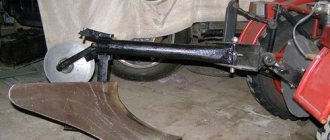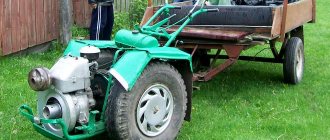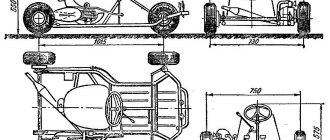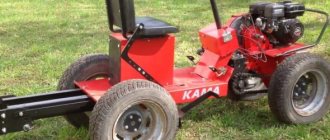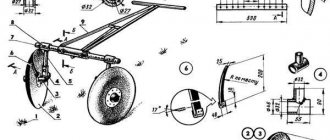Lifting weights and moving them from one place to another requires enormous amounts of effort and time.
As a rule, such a need arises during the construction of a private house.
To avoid straining yourself too much, it is advisable to use a crane.
Typically this structure is made of metal. However, if your budget is very limited, you can make a crane out of wood.
In today’s article we will look at how to make a wooden crane for construction with your own hands. The author of the YouTube channel “House Builder” shared his personal experience.
You may also be interested in reading the article: how to make equipment for working with a drill
.
Machine structure
The operating principle of a crane is based on the physics of simple mechanisms. The simplest version of the crane is a stick placed on a fulcrum in such a way that the free ends have different lengths. Now if you hang a load on a short lever, it will take less effort to lift it. The most common design is one that uses, in addition to levers, a system of blocks.
A do-it-yourself crane is an indisputable assistant in small-scale construction. When constructing a private house, the use of bulky industrial cranes is not required. The height of the houses rarely exceeds 2 floors, and the weight of the lifted load is 200 kilograms.
Crane diagram
Although there are many variations of lifting mechanisms, a classic crane consists of the following parts:
- An arrow with a block attached to its end. Depending on its length, the height to which the load can be lifted is determined.
- Platform. The boom and counterweight are attached to it. It is the main part of the crane and is subject to significant loads. Therefore, when manufacturing a platform, it is important to pay special attention to its strength.
- Counterweight. Serves for crane stability. Defines the maximum load weight that the crane can lift. Stackable counterweight options are available to provide maximum stability.
- A guy wire connecting the boom and the counterweight. Allows you to adjust the tilt of the boom and move the load in both vertical and horizontal planes.
- Winch with cable. It is the lifting mechanism itself. The power of the winch determines how much weight the crane can lift.
- Stand with a rotating mechanism. It is necessary to turn the crane to the sides.
- The support cross, which is the base of the crane. Sets the stability of the entire structure. When manufacturing it, you should also pay attention to its strength.
Crane assembly
At the last stage, all that remains is to secure the rack with the boom to the support platform and install the crane in the working position.
terms of Use
To operate lifting mechanisms safely, certain rules must be followed.
Homemade Pioneer crane
These rules apply to any lifting device:
- The load capacity must not be exceeded. A load that is too heavy may damage the device.
- The base must be stable. Homemade lifting devices should be located on a previously prepared hard horizontal surface.
- In bad weather conditions, you should also refrain from working with the crane. Strong winds will throw the crane off balance, and poor visibility may make it difficult to see people under the boom.
- Before operating a crane or lifting device, it is necessary to conduct an external inspection to identify any malfunctions. If malfunctions are detected, operation of the crane is prohibited.
- It should be remembered that when working with the lift, you should not make sudden movements. The load must be lifted smoothly. And most importantly, do not stand under any lifted load.
Pioneer-2000
The Pioneer-2000 crane is an improved version of the KP-1000 lift. After upgrading the model, the liftable load can reach 2 tons. This module is manufactured by the manufacturer to special order and is in demand in the construction of facade structures, when installing windows and sandwich panels.
Features of the 2-ton truck:
- equipped with electromagnetic hydraulic brake;
- electric drive for boom rotation;
- gearbox, power unit and winch with a 4-fold safety margin.
Taking into account the console reach, the maximum lifting capacity with double reeving of the rope is:
- with a reach of 4.6 m - 1500 kg;
- 4.4 m - 1700 kg;
- 4.1 m - 2000 kg.
Maximum lifting height of the hook mechanism:
- at reach 4.6 m - 4.3 m;
- 4.3 m - 4.5 m;
- 4.1 m - 4.65 m.
The maximum depth of lowering the hook is 100 m with a double safety margin of the rope.
Unit operating speed:
- with single reeving - 5.6 m/min;
- at double speed - 11.3 m/min.
The rotating part moves 360° around the axis. The turning radius reaches 3 m.
Structural weight - 1.5 tons.
What characteristics should a garage lift have?
In garage conditions, two types of lifting mechanisms are used. The first type includes a lift that can lift the entire car, and the second type includes a goose-type lift that allows you to move loads around the garage.
Lifts of the first type are stationary devices and the main requirement for them is stability. The car weighs more than a ton and should not have the slightest chance of falling. In order to prevent any accidents, the garage lift must have a reliable stopper.
Homemade goose tap
The goose type lifts are most often used in auto repair shops. It is quite simple to make it from a profile pipe or channel. First, the base is welded on which the rotating mechanism needs to be installed. It is best to make an arrow with an adjustable reach. This will make it possible to move weights in any direction.
conclusions
The mini cranes shown above are well-proven, inexpensive designs that have proven their effectiveness. Any self-builder who has a welding inverter, an angle grinder and a drill can make similar models. If you need more advanced homemade cranes with heavy lifting capacity, we recommend the following articles:
ART-HOUSE: Decorating an unusual house with mosaics and a magical interior. Its author, an artist-architect, talks about an unusual designer house built without hired workers.
Source
How a simple block design works
The pulley system or pulley system has been known to mankind since ancient times. The classic system design consists of pulleys and cable. One pulley is called a block. Depending on the method of fastening, the pulley can be movable or fixed:
- Fixed block. It is attached to the support and plays the role of changing the direction of movement of the rope. Does not provide any gain in strength.
- Movable block. It is located on the side of the load and gives a gain in strength.
The principle of operation of a pulley block is similar to the principle of operation of a lever in the physics of simple mechanisms. The role of the lever in this case is played by the cable itself. In the case of a simple block of two pulleys, the movable pulley divides the rope into 2 parts and in order to lift the load the same distance, a rope twice as long will be required. The work of lifting the load is performed in the same volume. And the effort, due to the fact that the length of the rope has become twice as long, becomes half as much.
If there are more than 2 pulleys in the system, the gain in strength is approximately equal to the number of blocks. In the case of 3 blocks, the effort will be 3 times less, and 4 blocks will require only a quarter of the original effort.
Small parts
To regulate the number of revolutions, you can use adapter wheels. They will make the movement of the manipulator hand smooth.
It is also necessary to ensure that the wires do not complicate its movement. It would be optimal to lay them inside the structure. You can do everything from the outside; this approach will save time, but can potentially lead to difficulties in moving individual components or the entire device. And now: how to make a manipulator?
Complex block system how to calculate power gain
If the system is designed in such a way that one simple pulley pulls another simple pulley, then this is already a complex system of blocks. To theoretically calculate the gain in strength, it is necessary to conditionally divide a complex chain hoist into simple ones and multiply the values of the gain from simple chain hoists.
For example, if the system consists of 4 blocks, and the first conditional simple pulley has a gain of 3. It pulls the second simple two-block pulley, also with a gain of 3. The total force that will need to be applied will be 9 times less. It is the 4-block complex chain hoist that is most often used by rescuers.
Garage hoist: drive manufacturing
You can make a hoist for lifting loads yourself. It is based on a brake lever that used to be on a truck. In a car, such a lever helps to supply the pads and reduce the gap between them.
To make a hoist with your own hands, you need to have skills in electric welding and turning.
The expansion knuckle shaft is cut to the required size using a lathe. The shaft is equipped with two washers. The entire structure is called a winding drum. One washer is equipped with a ring on the inside so that it does not interfere with the free passage of the cable.
Important Line of electric and petrol trimmers AL-KO (Alco)
How to make a drive:
Before manufacturing the lift, it is necessary to prepare drawings. The finished device can be used to lift and lower a centrifugal pump and other types of loads. As an alternative to this type of crane, you can make a hydraulic “Goose” crane.
To lift the engine and body in the garage, you will need a special mechanism. They are expensive, so you can save money by making them yourself. To do this, you must first familiarize yourself with the types of lifting mechanisms and their functionality. After choosing the type of mechanism, you need to start drawing up drawings and an assembly plan for the structure. For self-production, it is better to have turning skills and skills in assembling mechanisms.
Source
Methods for attaching a rope to a lifting mechanism
When creating complex pulley blocks, there are often situations when a cable of the required length for attaching the moving block is not at hand.
Crane for gas blocks
Methods for attaching a cable using general-purpose rigging:
- Using a cord. Using a self-tightening knot, the cord is tied to the main cable. As the load is lifted, the grappling knot moves along the main rope, thereby allowing the height of the load to be increased.
- Using clamps. In the case of using a steel cable, it is not possible to use a cord, so it is necessary to use special clamps.
Pioneer-750
The Pioneer-750 crane has technical indicators similar to the 500th model.
Module features:
- the mass of transported cargo is increased to 750 kg;
- lifting speed - 8.4 m/min;
- moving height - 45 m;
- manual rotation - using a special lever;
- load lifting mechanism - AIR100L4EU3 electric motor with a rated power of 4 kW and a rotation speed of 1410 rpm on 3-phase alternating current;
- control is carried out by a 220 V remote control;
- most units are made stationary, the booms are non-removable with a reach of 4.5 m;
- dimensions - 4.2x2.0x5.4 m;
- transport width - 2.18 m;
- transport length - 2.67 m;
- height - 1.35 m;
- weight - 1355 kg.
We create a simple lifting mechanism with our own hands
Construction of a crane is not a quick task and is justified if it is required frequently or the volume of work is large enough. In cases where the load needs to be lifted urgently or this is a one-time operation, you can use improvised means.
To create a simple lifting device you will need a cord and two blocks. One block and the end of the rope are fixed motionless on the support. This will be the highest point to which the load can be lifted. We attach the second block to the load using slings or a hook. We first pull the rope along the block attached to the load, then pass it through the upper block. The gain in power will be 2 times. Using your own weight, you can easily lift a load weighing 100 kilograms to the required height.
DIY mini crane
If you add the ability to move the upper block along a guide, for example along a rail, you can get a do-it-yourself jib crane. It is useful in garage conditions for moving heavy machine parts.
It should be remembered that when working with the lift, you should not make sudden movements. The load must be lifted smoothly. And most importantly, do not stand under any lifted load. The same rule applies to a crane - standing under the arrow is prohibited.
Detailed instructions on how to make a homemade crane for building a house
Almost any construction site cannot be done without special equipment, especially a construction crane. It becomes an indispensable assistant when it is necessary to lift heavy loads to different heights.
Most people associate this technology with huge size, but there are many types of faucets that are ergonomic and compact.
You can even do some options yourself, saving personal savings during construction. In this article we will look at how to assemble a homemade Pioneer crane for building a house.
Mini construction crane: scope of application
Mini cranes are in great demand. They are used during construction and repair work. Modern manufacturers offer innovative solutions in the manufacture of their products.
These devices are different:
- maneuverability;
- wide range of applications;
- functionality;
- ease of use.
Thanks to the presence of various attachments, various manipulations can be carried out with this technique.
Mini cranes, both purchased and assembled at home, are capable of working in the most difficult to reach places: in cramped courtyards, dense urban construction, uneven sites, inside buildings and on roofs. Compact dimensions allow special equipment to even pass through single or double doors.
They are often used for fine, almost jewelry work. Manufacturers of modern technology conducted an experiment with a matchbox that had to be moved from one place to another. At the same time, the device did not crush or crush a cardboard box of such a tiny size.
The presence of a control panel for the units allows users to control the work process while standing next to the equipment near the load, but only purchased units assembled in production have such advantages.
You are unlikely to be able to make such a device yourself. But you can try to build something similar. Of course, a mini crane assembled by yourself will not be very functional, but it will be able to lift loads of a certain mass to a specified height.
Simple mini-faucet with your own hands
If you make a mini crane with your own hands, it will be able to lift loads weighing up to 250 kg. This will greatly simplify the construction process on site. It can handle lifting logs, concrete mortar, and roofing materials. With it, you can do construction yourself without involving a large number of workers.
The main thing when making a mini crane is to prepare a drawing, the necessary tools and parts. The weight of this structure can reach 300 kg. It depends on what materials you will use during assembly. Despite its impressive weight, the mini crane will be distinguished by its compact size and high performance.
Assembling a mini crane with your own hands consists of the following steps:
- Using a gearbox, a cargo winch is attached to a worm base.
- Construction supports are the basis for screw outrigger systems.
- In addition to the basic structure, drums for winches will be required to assemble the unit. Making them on your own is quite problematic. Therefore, it is recommended to purchase ready-made products.
- Rotors from an electric motor can be used as a basis.
Attention: when assembling a mini crane yourself, special attention must be paid to the ratio of the sizes of the elements and the dimensions of the future device.
To make the device convenient to use, its platform can be equipped with wheels. This is where the old transport cart comes to the rescue.
Features of mini cranes assembled by yourself include:
- The optimal boom height is 5 meters. To make it yourself, you will need to use a pipe with a diameter of 8 cm.
- A profile of 2 corners is mounted on the base and a rotating mechanism is created to rotate the boom. An automobile hub from a truck is suitable as a turning mechanism.
- To build a counterweight, you don’t need any special materials. Ordinary bricks can serve as them.
Types of manual taps
All construction cranes are classified into:
- self-propelled;
- stationary;
- tower;
- special purpose.
This equipment is equipped with a boom extension mechanism, a cargo trolley, and a rotating support.
By type of movement they are divided into:
- stationary;
- adjustable;
- self-elevating;
- mobile.
According to the type of control, these devices are electrically driven and manual (mechanical).
Lift
Modern lifts are divided by type into:
- Foot. They are capable of lifting heavy loads weighing up to 2 tons to a height of 8 meters.
- Telescopic. Their advantages include: light weight and compactness. These devices are capable of lifting loads to a working height of up to 150 kg.
They, in turn, are divided into:
When choosing a lift, it is worth considering several factors: their dimensions, load capacity, scope of application.
To make a lift yourself, prepare materials and a preliminary drawing. To build it we will need:
- a winch, which can be made from a drum and a cable;
- pipes;
- electric drive
Materials and tools
The most important thing when making a crane is to use high-quality tools and materials. This will guarantee that the structure will be strong and safe.
The cable should have minimal stretch; this will give a greater gain in strength when using a pulley system. The fittings used for tying must be taken only from metal. Plastic fittings cannot withstand heavy loads and break at the wrong time. To fasten individual parts of a homemade crane, you should choose high-strength hardware products.
If a winch is intended to be used, its lifting capacity should not be less than 500 kilograms. The best choice would be winches that can lift a load weighing 1 ton or more.
In conclusion, I would like to once again remind you of the need to observe safety precautions when working with lifting mechanisms. Also, regardless of whether the crane is purchased or made by yourself, you should inspect it before starting work.
Main types of equipment
The average garage has a reduced square footage and requires careful selection of equipment. Before installation, it is recommended to carefully study the need for individual mechanisms, their types, pros and cons. A hydraulic valve is determined by two criteria.
By type of drive
There are also two subtypes of hydraulic drive:
- automated design with hydraulic cylinders;
- combined, with hydraulic cylinders and manual winches.
A significant drawback of the first is oil cylinders. They need frequent regular replacement, so this design is considered extremely unprofitable for constant use. The combined system will last longer. However, some of the work with winches will have to be taken on by mechanics.
According to the design of the support
Hydraulic cranes are divided into mobile and stationary, they can be folding and prefabricated cast (goose). For ordinary garages, it is more rational to choose a mobile structure with folding parts.
Blueprints
To make a crane, first of all, draw up a project diagram and drawings of the main components. Consider the manufacture of a manually operated crane structure. It would be possible to make a device powered by electricity, making it possible to move a load using a device on a long cable, as happens in factory designs. But then the complexity of manufacturing units increases, this will entail an increase in the cost of the finished product and an increase in the time for its creation. Therefore, we will focus on making a manual model.
Industrial development[edit | edit code]
Electrical engineeringedit | edit code
Once a sufficient amount of latex, red dust (), copper, iron and tin has been found, you can begin to manufacture a generator - the first source of electrical energy, as well as the first consumer of electricity - an electric furnace (), which works almost twice as fast as a conventional one. To create an electric furnace you will need copper and red dust, because you will definitely need an electrical circuit.
IndustrialCraft² recommends that mined ore be first crushed in a crusher and only then smelted. Thus, from one block of ore you get 2 ingots, instead of one. Therefore, the sooner the crusher is manufactured, the better. There is also an ore washing machine and a thermal centrifuge, which allows you to wash even more resources from crushed ore. Likewise, it is recommended not to melt latex in a furnace to make rubber, but to use an extractor, as it squeezes more rubber out of the latex. The crusher, ore washing machine and extractor are also consumers of electricity.
Miner's affairs | edit code
At the initial stage of development in this mod, when a lot of iron has been accumulated, it is worth stocking up on stone pickaxes and one iron one and going to the mine (cave or canyon). It is recommended to stay in it for an hour or two of real time, mining a pile of , various stones (stone, coal, lapis lazuli, obsidian, diamonds) and red dust, so that later, during any complex or not very difficult crafting, you do not have to run into the mine for new portions of useful resources.
Subsequently, a mining laser and a drilling rig (used for automatic extraction of resources) will be very useful in mining.
Agricultureedit | edit code
The agricultural complex can be effectively used for the player’s life thanks to perches (which simplify farming) and plant selection. For example, Ferrium yields a small pile of iron dust as a harvest, and Aurelia yields a gold nugget. A mug of coffee is extremely useful, as it gives the player more energy, making him move faster. A coffee mug () is crafted from coffee fruits.


